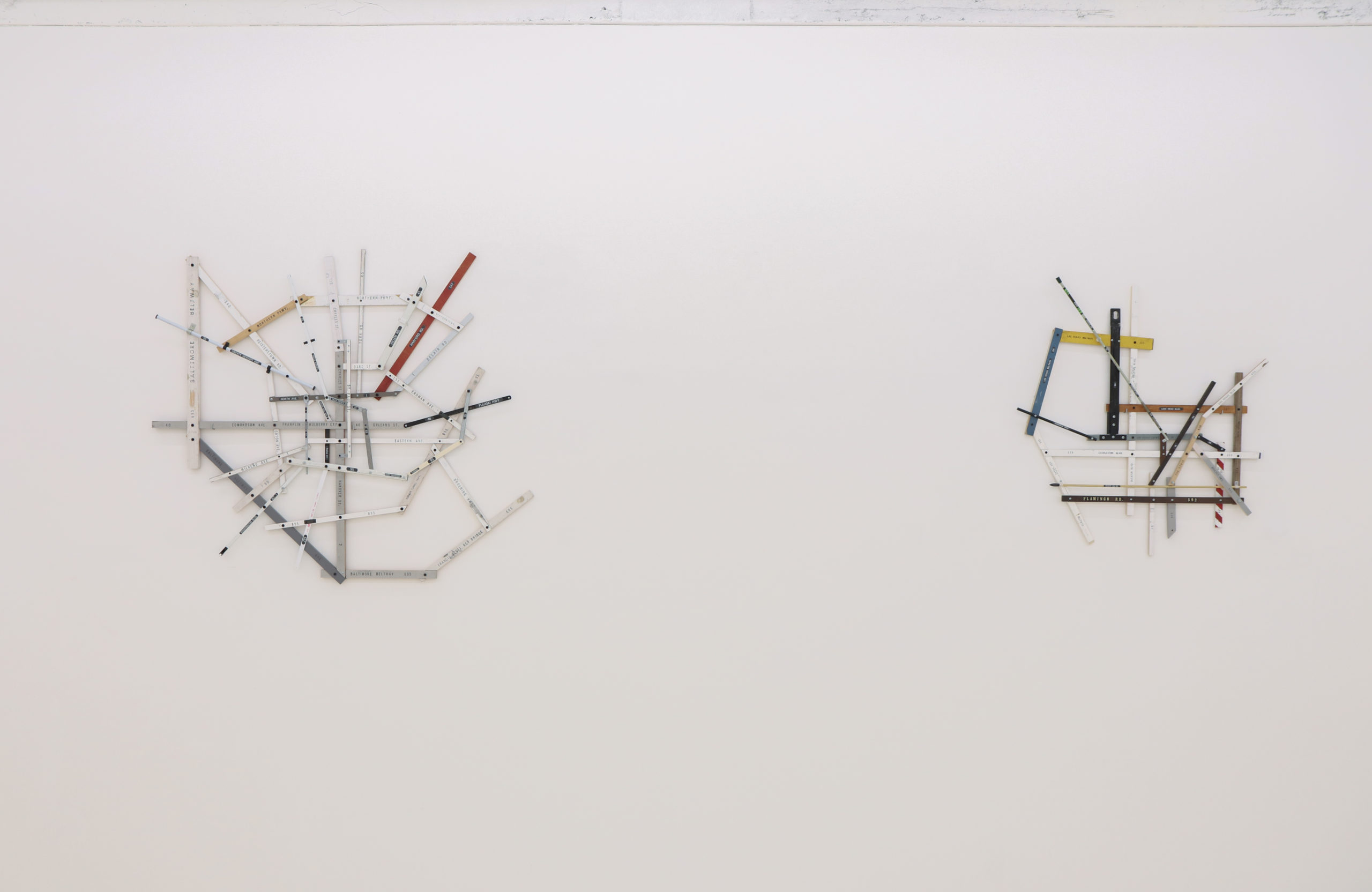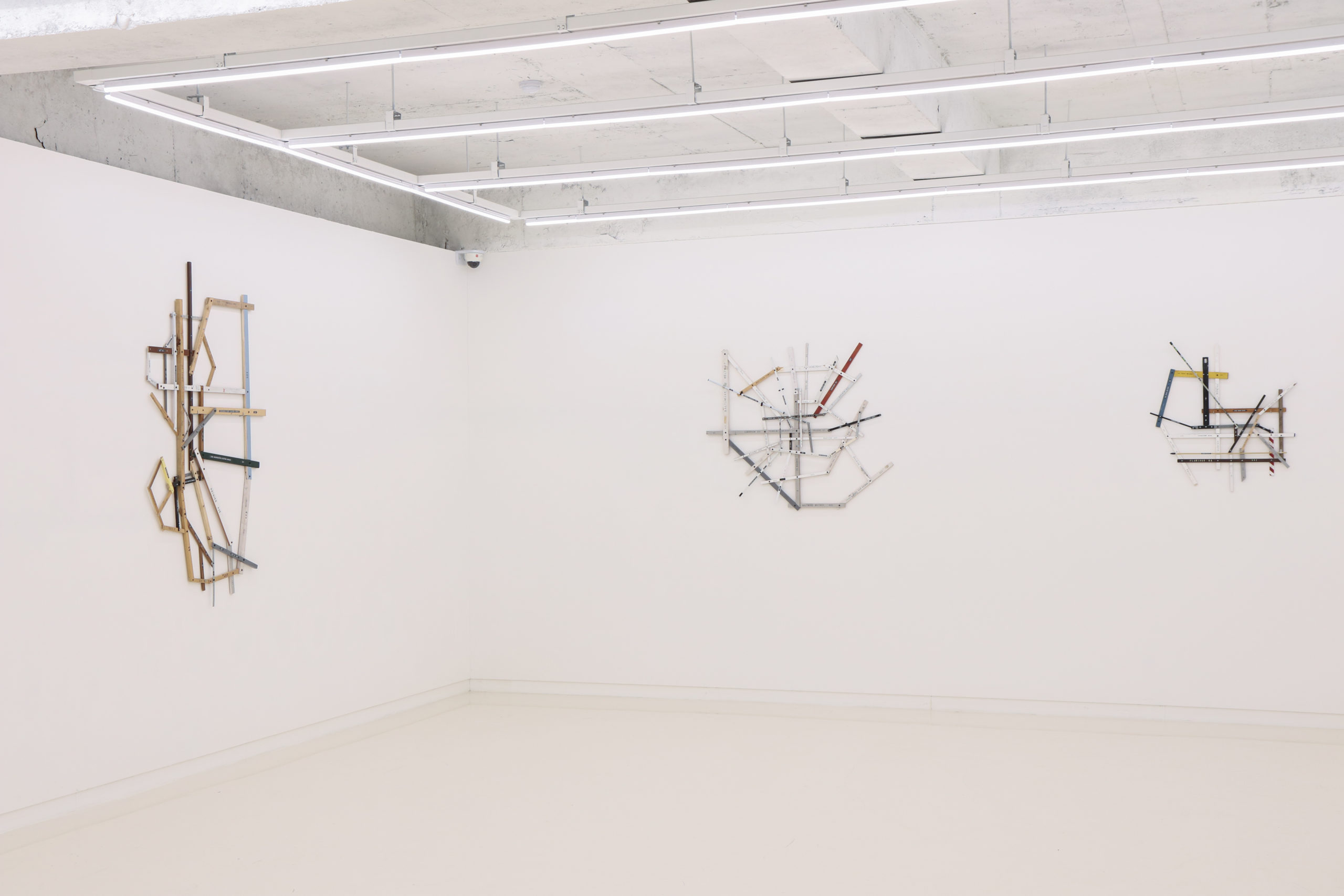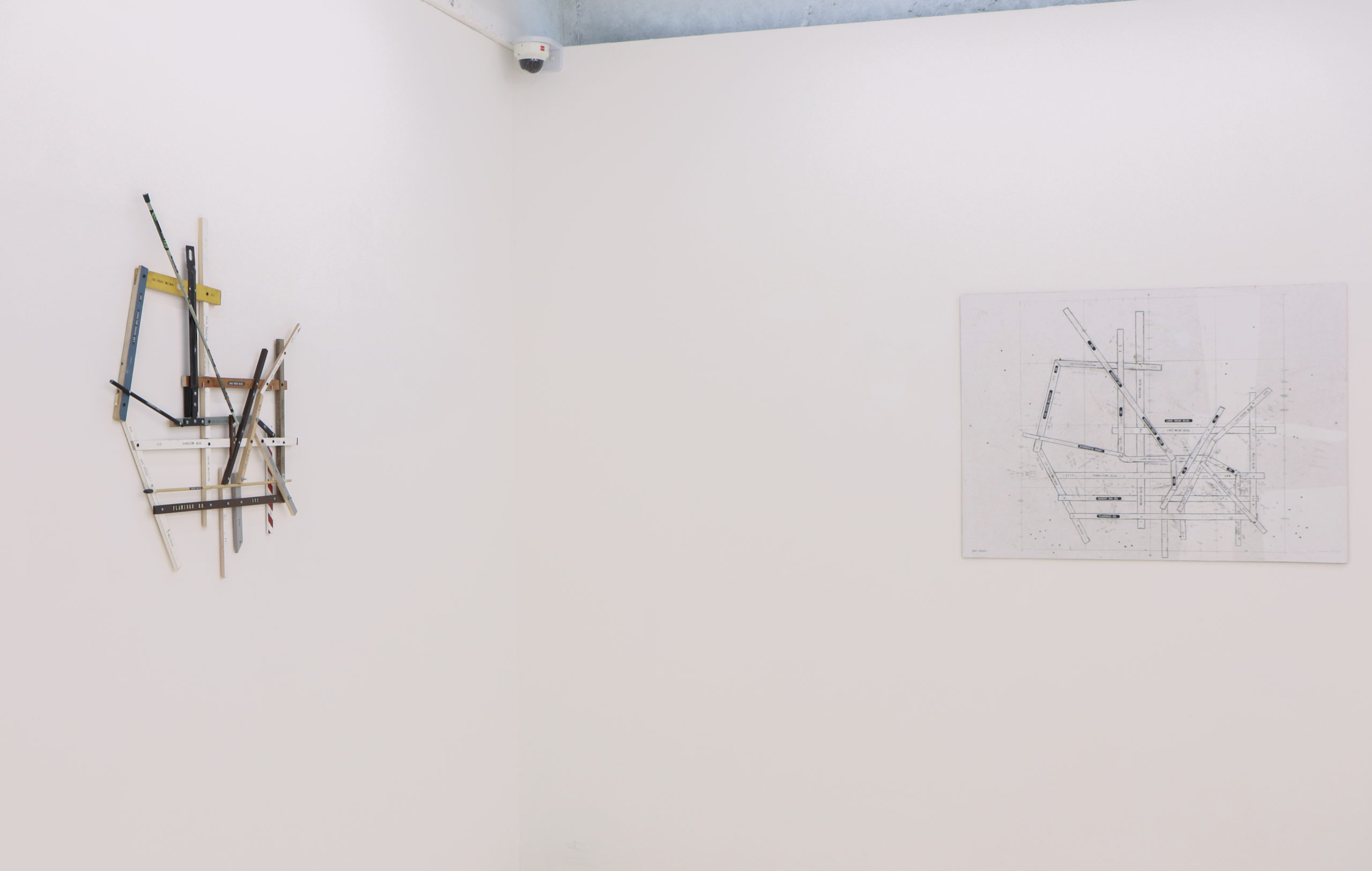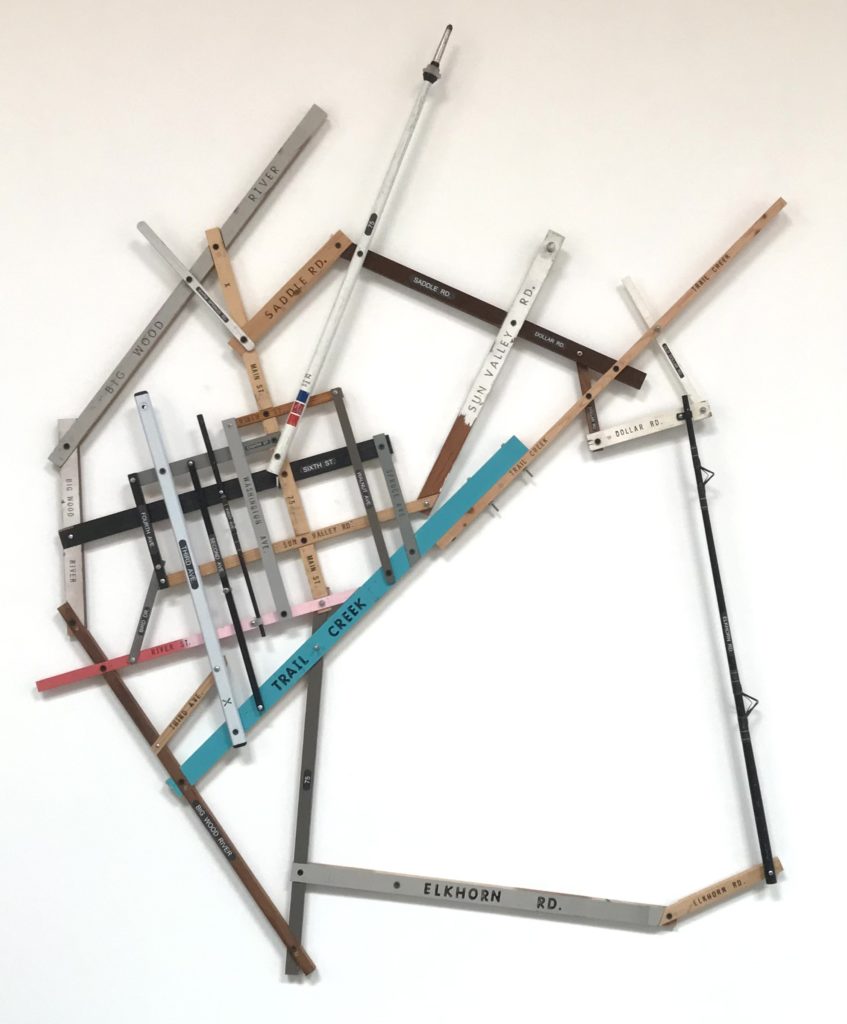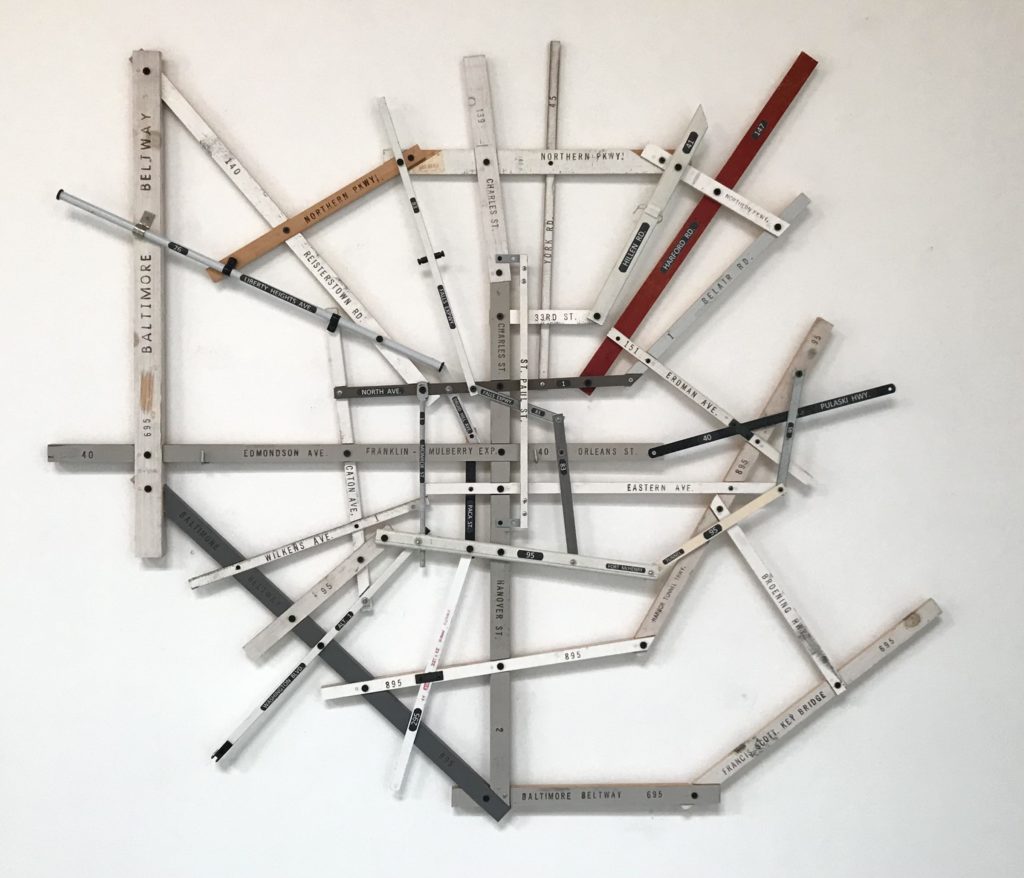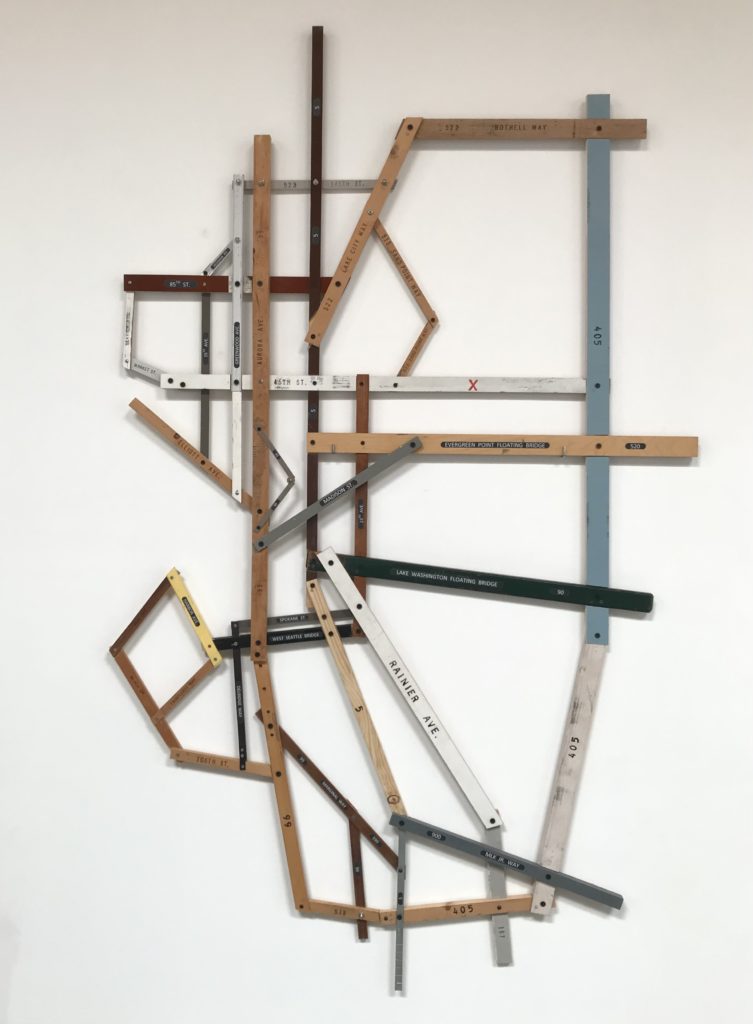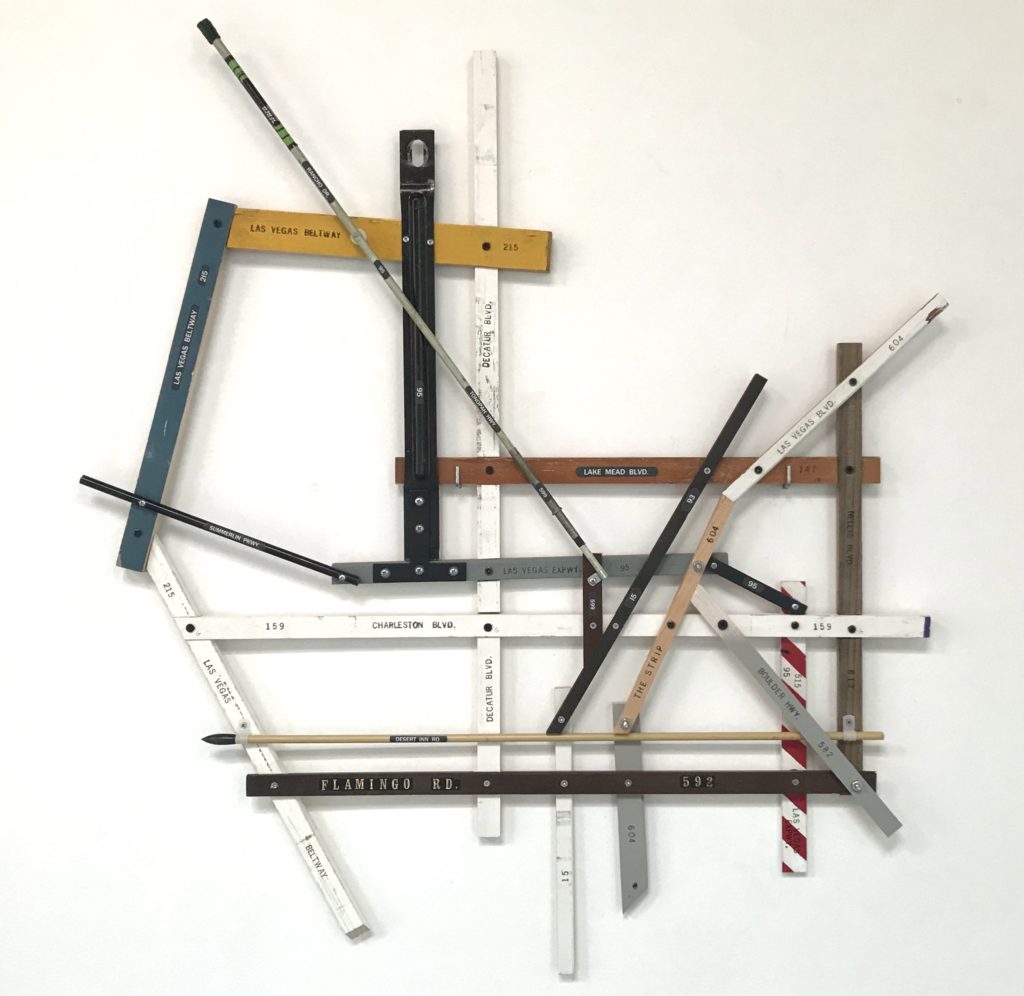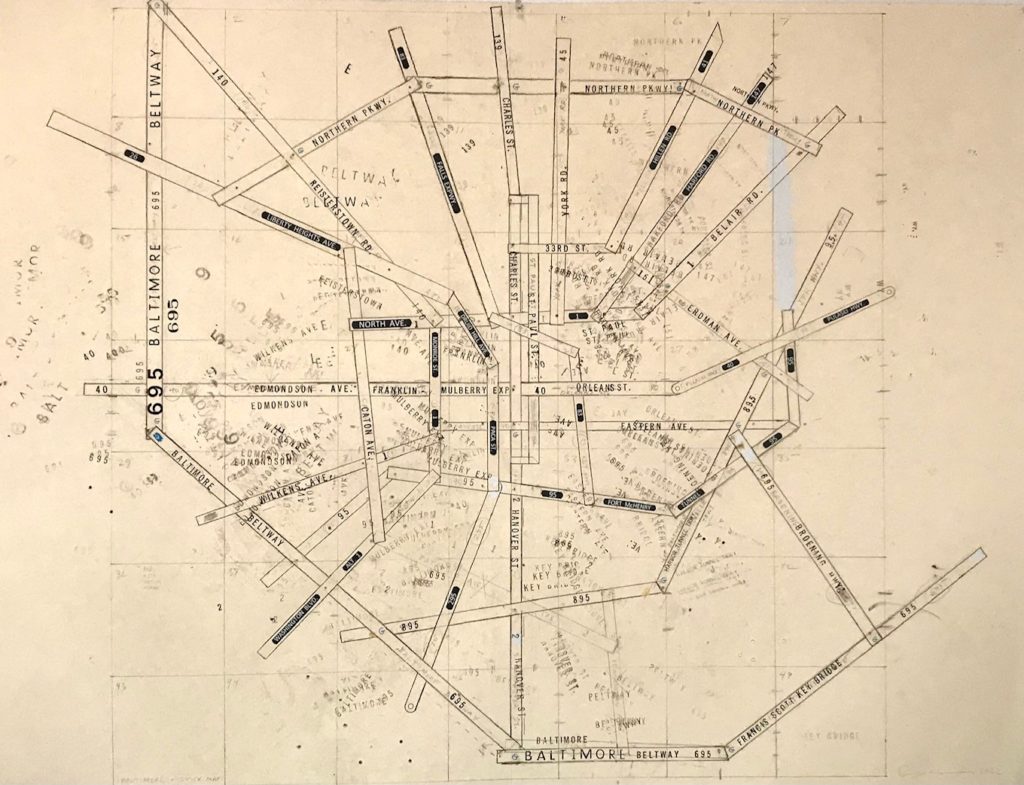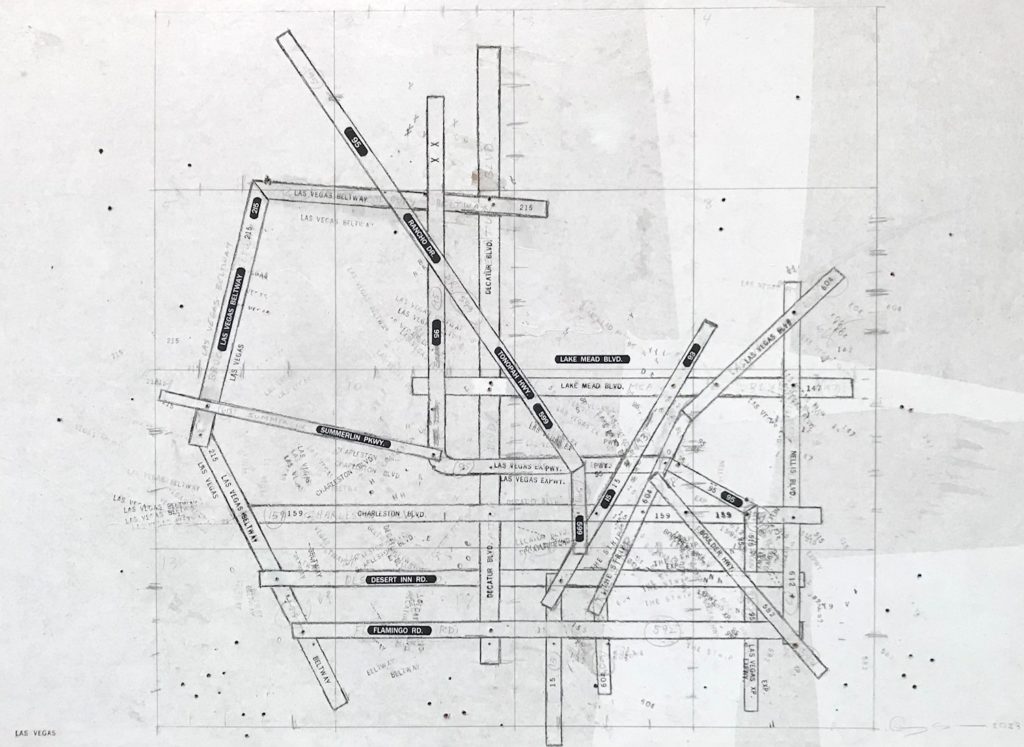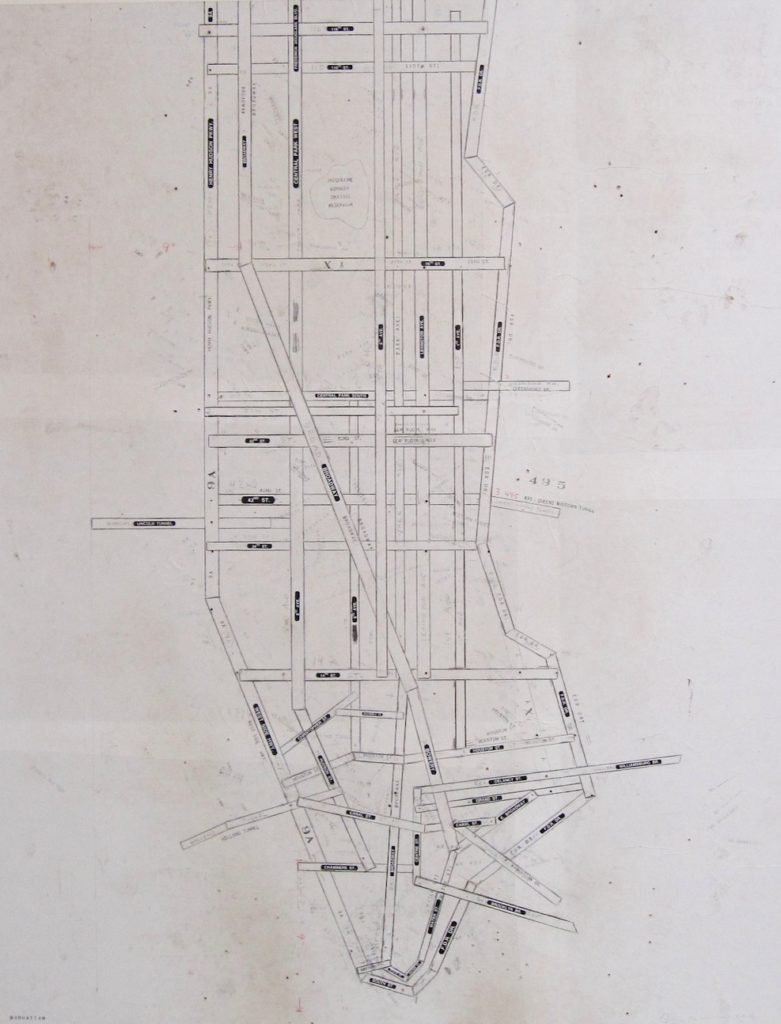Main Street is a Memory
Greg Colson
May 18 - Jul 8, 2023
Wed - Sat, 11am - 6pm
Maps are beautiful. (There are all kinds of maps; here, I am thinking about geographic maps.)
Lines are intricately intertwined, colored planes are side by side, and mysterious names of the places are written on them. Maps are a visual and symbolic result of explorers' and scientists' discoveries, which always make us discover something new. Above all things we find on the maps, we discover where we are. The experience of looking at a map involves a radical change in our viewpoint, which gives us a little "high" of locating ourselves in the world. Just as a loaf of well-baked bread is beautiful, so are maps. Both are crucial to our existence.
"Geography is the wife of history, as space is the wife of time," said an American writer and literary scholar, Guy Davenport. Just as we cannot think of time without space, we cannot think of history without geography. The same goes for an individual's history. Everything surrounding us happens in specific places, and our memories are inevitably related to spatial awareness. Neurologists found that the part of the human brain responsible for orientation and navigation is the hippocampus in the frontal lobe, which is also responsible for the long-term memory of human beings. Only humans build their identity by storing memories chronologically in the hippocampus. So, when Alzheimer's patients lose their memory, they also get lost and forget who they are. The history of human evolution began when Homo Sapiens left Africa and embarked on a long journey. The human ability for mapping and navigation is the reason for human existence.
Greg Colson uses various graphic works, such as maps, graphs, and diagrams, as the subject matter of his work. He has worked on the stick map series since he created the first stick map in 1988. In 1994, Robert Storr curated an exhibition called "Mapping" held at MoMA, where he presented works based on maps by artists such as Alighiero e Boetti, Jasper Johns, Ellsworth Kelly, Sol LeWitt, Greg Colson, and others. Robert Storr talks about Greg Colson's stick map in his catalog essay:
The maps of Californian Greg Colson derive their character from the aesthetic convergence of the strip and the scrap. The strip is the dominant axis of the US car-dependent metropolis and should be used as a collective rather than a singular noun since the more they mushroom outward, the more intricately our cities are crisscrossed by such matrices. Main Street is a memory….. The scrap is the antithesis of the strip: it is an absolutely particular thing the discard people traveling and consuming at high speed have no further use for…. The scavenging artist might, however, discover that it perfectly fulfills a function in some evolving image. In an ongoing suite of urban plans….Colson has rescaled the expanse of the West Coast cities he knows to the specific quality of the materials he selects.
Greg Colson's stick resembles a road; a road resembles our ongoing memories. Social media, virtual reality, and the metaverse add unthinkable layers to our world; it is no longer possible to visualize it on any map. Greg Colson's stick maps stay incredibly low-tech in a high-tech world with no view. They are made of discarded objects in a deceptively simple way, but they are specific and undeniable presence, stained with human events and memories. As the memories of the places and streets are interwoven in our minds, his sticks intersect each other as if governed by some elegant physics.
Mimi Park
Greg Colson
Greg Colson is an American artist whose work is marked by a jarringly direct commingling of material and conceptual elements. In his constructions, precisely rendered systems are disrupted and contradicted by the contexts they are placed in. By drawing out the poetry and humor in our social patterns, Colson seems to suggest there are limits to – and hazards inherent in – our obsession with efficiency, data, and analysis of every kind. A critic and poet John Yau described Colson’s work in a recent article in HYPERALLERGIC Colson “has brought together a penchant for exactness with a sensitivity to detritus and waste. By being meticulous in his interaction with abandoned things, Colson infuses the act of care and attention with pathos.” Colson grew up in Bakersfield, California and lives and works in Los Angeles.
Colson’s art has been the subject of over 40 solo exhibitions internationally, including Sperone Westwater (New York, USA), Craig Krull Gallery (Los Angeles, USA), Konrad Fischer Gallery (Dusseldorf, Germany), Cardi Gallery (Milan, Italy), Sprovieri (London, England), Thomas Park Gallery (Seoul, Korea), Baldwin Gallery (Aspen, CO., USA), Kunsthalle Lophem (Bruges, Belgium), Krannert Art Museum (Urbana-Champaign, IL., USA), and the Lannan Museum (Lake Worth, FL., USA). His work is in collections throughout the United States and Europe, including the Whitney Museum of American Art (New York), Museum of Modern Art (New York), Museum of Contemporary Art (Los Angeles), Getty Research Institute (Los Angeles), Los Angeles County Museum of Art, The Panza Collection (Varese, Italy), Sammlung Rosenkranz (Berlin, Germany), and Moderna Museet (Stockholm, Sweden).
지도는 아름답다. (이 세상에 다양한 지도들이 있지만 여기서 난 지형 지도를 생각한다.)
선들이 섬세하게 겹치고 교차하며, 색면들이 서로 맞닿아 있고, 여러 장소의 신비로운 이름들이 그 위에 적혀있다. 지도는 탐험가와 과학자의 발견들 축약한, 시각적이고 상징적인 결과물이다. 이 발견의 결과물에서 우리는 언제나 무언가를 새로 발견하게 한다. 무엇보다 우리는 지도를 통해 우리의 위치를 발견하게 된다. 지도를 본다는 경험은 우리가 몸 담고 있는 거대한 세상을 향하는 시점을 급진적으로 바꾸는 일이고, 이 종잡을 수 없는 세상 속에서 나의 위치를 파악하는 데서 오는 감동이 있다. 잘 구워진 한 덩이의 빵이 아름다운 것처럼 지도는 아름답다. 우리의 생존에 너무나 유익하기에 언제나 아름다운 것일까.
“공간이 시간의 아내인 것처럼 지리학은 역사의 아내이다.”라고 미국의 작가이자 영문학자 가이 다벤포트가 말했다. 공간을 배제한 시간을 생각할 수 없는 것처럼 지리를 제외한 역사를 생각할 수 없는 것이다. 한 개인의 역사도 마찬가지다. 우리를 둘러싼 모든 일은 구체적 공간 속에서 일어나고 우리의 기억은 어쩔 수 없이 공간 지각과 연관되어 있다. 신경학자들은 인간의 뇌에서 지남력과 위치 인식을 관장하는 곳은 전두엽의 해마라는 곳인데 이곳은 또한 인간의 장기 기억을 관장하는 곳이라고 한다. 인간만이 해마에 기억을 시간순으로 저장하면서 자신의 정체를 만든다고 한다. 그래서 알츠하이머 환자들이 기억을 잃으면 동시에 길을 잃어버리고 자신이 누군지도 잊는다고 설명한다. 인간 진화의 역사는 호모 사피엔스가 아프리카를 떠나 긴 여행을 시작하면서 시작되었다. 인간의 지남력은 인간 존재의 이유라고 해도 과언이 아니다.
그렉 콜슨은 지도, 그래프, 도표 등 인간의 다양한 그래픽들을 작업의 소재로 한다. 그는 1988년 최초의 스틱 맵을 제작한 이래로 계속 스틱맵 작업을 해왔다. 1994년 로버트 스토는 모마에서 열린, “맵핑”이란 전시를 기획하여 알리기에로 에 보에티, 재스퍼 존스, 엘스워드 켈리, 솔 르위트, 그렉 콜슨 등 작가들의 지도를 소재로 한 작업들을 선보였다. 로버트 스토는 전시 글에서 그렉 콜슨의 스틱맵 작업에 대해 이렇게 말한다
캘리포니아 출신 그렉 콜슨의 지도 작업은 대로와 버려진 물건의 조합에서 나온 미학에 기반한다. 대로는 차에 의존하는 거대한 도시를 이루는 축으로, 이 단어는 단수 명사가 아니라 집합 명사로 사용되어야 한다. 대로들이 더 뻗어나가야 우리의 도시들이 서로 교차될 수 있기 때문이다. 대로는 기억이다….버려진 것들은 어쩌면 대로와는 대조적이다. 이는 매우 구체적인 사물들로, 바쁘게 움직이고 살아가는 사람들이 소비한 후 더이상 필요없어진 물건들이다. 하지만 작업의 재료를 찾아 헤매는 작가라면 이 물건들이 진화하는 어떤 이미지에서 완벽한 역할을 할 수 있다는 것을 발견하게 된다. 끊임없이 성장하는 도시 환경 속에서 콜슨은 이 거대한 도시들을 그가 선택한 재료의 매우 구체적인 성질에 맞게 그 크기를 재조정한 것이다.
그렉 콜슨이 사용하는 긴 막대기는 길을 닮고, 길은 우리의 이어지는 기억을 닮는다. 우리가 살고 있는 세상은 소셜미디어와 버츄얼 리얼리티, 메타버스가 층을 더하며 더이상 어떠한 지도로도 조망이 불가능하다. 조망이 사라진 하이테크의 세계에서 그렉 콜슨의 스틱맵은 믿을 수 없을 정도로 로우테크이다. 버려진 물건들로 간단하게 만들어졌지만 인간의 사건들과 기억이 묻은, 구체적이지만 부정할 수 없는 존재감을 지닌다. 긴 조각 같은 기억들이 우리의 머릿속에서 직조되듯, 그의 스틱들은 어떤 우아한 법칙에 의해 서로 교차하고 있다.
박상미
그렉 콜슨
그렉 콜슨은 재료와 개념적 요소를 직접적인 방식으로 혼합하는 작업을 특징으로 하는 미국 예술가이다. 그의 정확하게 렌더링된 작업은 작업이 배치된 맥락과 상치되는 특성을 갖는다. 우리 사회의 관습을 시정과 유머로 그려내는 콜슨은 효율의 추구, 데이터 및 분석에 대한 우리의 집착에 한계와 위험이 내재되어 있다고 제안하는 듯하다. 비평가이자 시인인 존 야우는 Hyperallergic에 실린 최근 평글에서 콜슨은 “버려진 것에 대해 세심하게, 동시에 정확하게 다가가는 경향을 지닌다. 콜슨은 버려진 것을 세심하게 다루어 작업하며, 보살핌과 주의를 기울이는 행위에 일종의 파토스를 불어넣는다.” 캘리포니아 베이커스필드에서 자란 콜슨은 로스앤젤레스에서 거주하며 작업 중이다.
그렉 콜슨의 작품은 Sperone Westwater (뉴욕, 미국), Craig Krull Gallery (로스앤젤레스, 미국), Konrad Fischer Gallery (뒤셀도르프, 독일), Cardi Gallery (이탈리아, 밀라노), Sprovieri (영국, 런던), Thomas Park Gallery(서울, 한국), Baldwin Gallery (애스펀, 미국), Kunsthalle Lophem (브뤼헤, 벨기에), Krannert Art Museum (일리노이 어배너 섐페인, 미국) 및 Lannan Museum (플로리다 레이크워스, 미국) 등에서 전시되었고, Whitney Museum of American Art (뉴욕), Museum of Modern Art (뉴욕), Museum of Contemporary Art (로스앤젤레스), Getty Research Institute (로스앤젤레스), 로스앤젤레스 카운티 미술관, The Panza Collection (바레세, 이탈리아), Sammlung Rosenkranz (베를린, 독일), Moderna Museet (스톡홀름, 스웨덴) 등에 소장되어있다.
